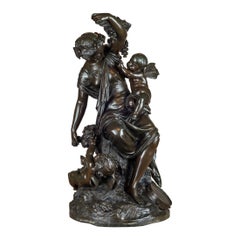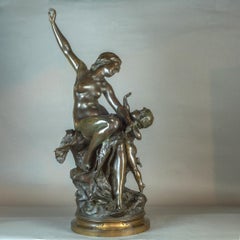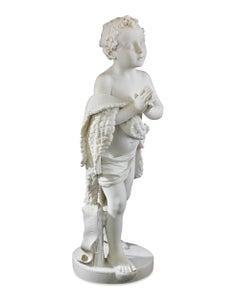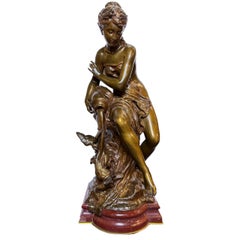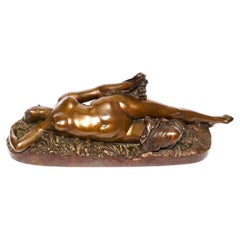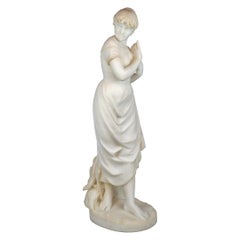19th Century Figurative Sculptures
to
49
213
108
137
66
45
Overall Width
to
Overall Height
to
172
569
2,188
7,511
69
43
104
114
60
118
200
172
216
266
58
6
4
2
2
1
448
324
322
276
264
157
107
69
53
41
33
20
17
16
14
13
11
11
10
10
398
387
127
115
41
27
16
7
7
7
366
202
Period: 19th Century
Grecian Mother and Two Children
Located in New York, NY
LOUIS AUGUSTE MOREAU
French, (1834-1917)
Grecian Mother and Two Children
Patinated bronze; Signed “MOREAU”.
22 x 25 inches
Category
19th Century Figurative Sculptures
Materials
Bronze
French Bronze Sculpture Statue by Alexandre Dercheu
Located in New York, NY
JULES-ALFRED-ALEXANDRE DERCHEU
French, (1864-1912)
L'Amour Désarmé
A nude girl holding Cupid away with her left arm, her left foot on his quiver, on a circular base, seated on a ro...
Category
19th Century Figurative Sculptures
Materials
Bronze
Young St. John the Baptist by Domenico Menconi
Located in New Orleans, LA
Masterfully carved with remarkable detail, a youthful Saint John the Baptist folds his hands in prayer in this stunning marble by the important Italian sculptor Domenico Menconi. The...
Category
Academic 19th Century Figurative Sculptures
Materials
Marble
"Sharing Water with the Birds" Bronze Statue by Mathurin Moreau
Located in New York, NY
A beauty sits on a rock, pouring water from a jug onto the rock beside her. Two birds play in the water as it cascades down the rock. The woman wears a crown of foliage and a piece o...
Category
19th Century Figurative Sculptures
Materials
Bronze
Jean Baptiste Auguste Clesinger Femme Piquée Par Un Serpent
Located in Dallas, TX
JEAN-BAPSITSE AUGUSTE CLÉSINGER (FRENCH, 1814-1883)
Femme piquée par un serpent
Inscribed J. CLESINGER and F. BARBEDIENNE. FONDEUR
Bronze, dark brown patina
8 in. (20.3 cm.) high, 22...
Category
19th Century Figurative Sculptures
Materials
Bronze
Italian Marble Statue of a Young Maiden by Cesare Lapini
Located in New York, NY
CESARE LAPINI
Italian, (1848-1893)
Segreto Al Cuore
Signed Prop ta Fratelli; Lapini; Firenze
29 1/4 x 8 x 11 inches
Notes:
A fine quality white marble sculpture of a you...
Category
19th Century Figurative Sculptures
Materials
Marble
Cesar Ceribelli bronze bust of Cleopatra
Located in New York, NY
CESAR CERIBELLI (French, 1841-1918)
Signed: ‘C. Cirribelli’
19th Century
22 1/2 in. x 13 3/4 in.
Category
19th Century Figurative Sculptures
Materials
Bronze
Cold-Painted Bronze Sculpture of a Woman Under a Palm by Franz Bergman
Located in New York, NY
A cold-painted cast bronze miniature statue depicting a north African woman picking dates from a palm tree. The incredibly crisp and detailed casti...
Category
19th Century Figurative Sculptures
Materials
Bronze
Bust of Frederick William Walker, 19th Century Figurative Sculpture
Located in London, GB
Hope-Pinker was born in Peckham, Surrey, the son of a stonemason and builder employing 5 or 6 men c.1871 in Hove, Sussex, who seems to have taught his son much of his stone-carving skills, although he also attended the Royal Academy Schools (c.1871). Hope-Pinker typically carved without a model from drawings. The bulk of his work was portrait sculpture and John Hunter...
Category
English School 19th Century Figurative Sculptures
Materials
Bronze
Fine Bronze Figures Entitled "Reveil de la Nature" by E. Picaul
Located in New York, NY
Signed 'E. Picault' inscribed and titled ‘Reveil de la Nature’ on self-base
Artist: Emile Louis Picault (1833–1915)
Origin: French
Date: Late 19th century
Dimension: 34 1/2 x 17 inc...
Category
19th Century Figurative Sculptures
Materials
Bronze
A Fine Quality Patinated Bronze Group of Maenad and Cherubs Dancing
Located in New York, NY
Inscribed 'A CARRIER Scpteur'
Title: A Maenad and Two Cherubs
Artist: Auguste-Joseph Carrier (1837-1908)
Origin: French
Date: 19th century
Dimension: 27 in. x 16 in.
Category
19th Century Figurative Sculptures
Materials
Bronze
Jeune Garçon et Chèvre
Located in New York, NY
EMILE LAPORTE
French, (1858-1907)
Jeune Garçon et Chèvre
Patinated bronze; Signed ‘Laporte’ on the white marble base.
40 x 17 1/2 inches
Category
19th Century Figurative Sculptures
Materials
Marble, Bronze
Bronze group of a winter scene
By Charles Georges Ferville-Suan
Located in New York, NY
CHARLES GEORGES FERVILLE-SUAN
French, 1847-1925
Bronze group of a winter scene
A winter scene of a man on skates, pushing the woman’s sled ...
Category
19th Century Figurative Sculptures
Materials
Bronze
Pair of Figural Sculptures of Seated Cherubs
Located in New York, NY
ALPHONSE H. NELSON
French, (1854-1919)
Pair of Figural Sculptures of Seated Cherubs
Signed to base
H 34 in. x W 18.50 in. x D 18 in.
Category
19th Century Figurative Sculptures
Materials
Bronze
The Swimmer
Located in Costa Mesa, CA
This very finely carved statue is of a swimmer just leaning over to dive into an unseen pool. Signed P. Barzanti, Florence for Pietro Barzanti (1825-1895) of Florence, Italy. Barzani was a well known sculptor known for classical works in marble which is reflected in this figure's very delicate facial features and the skill shown in the carving of her hair and the cloth of her bathing costume...
Category
19th Century Figurative Sculptures
Materials
Marble
Playing the Mandolin
Located in New York, NY
LUCA MANDRASSI
French-Italian, (1848-1919)
Playing the Mandolin
Patinated bronze; Signed L. Mandrassi; stamped Tiffany & Co., Cast from a model by L...
Category
19th Century Figurative Sculptures
Materials
Bronze
An Important Henri Godet Patinated Bronze Group Depicting Cupid and Psyche
By Henri Godet
Located in New York, NY
The love story of Cupid and the beautiful princess Psyche. Godet’s mastery is evident in this figural group, especially Cupid’s pointed wings, the gaze, the drapery, curved body, and...
Category
19th Century Figurative Sculptures
Materials
Bronze
Pair of Figural Bronzes
Located in Lambertville, NJ
Jim’s of Lambertville is proud to offer this artwork:
Bronze Sculptures of classical nudes
Category
19th Century Figurative Sculptures
Materials
Bronze
Guerrier Arabe Sur un Dromadaire
By Émile Pinedo
Located in New York, NY
EMILE PINÉDO
French, 1840-1916
Guerrier Arabe Sur un Dromadaire - Warrior On a Camel
Signed Pinédo with the bronze Garanti au Titre seal, titled
Patinated bronze, brown patin...
Category
19th Century Figurative Sculptures
Materials
Bronze
Egyptian Dancer
By Jean-Joseph Alexandre Falguiere
Located in New York, NY
JEAN-JOSEPH ALEXANDRE FALGUIERE
French, (1831-1900)
Egyptian Dancer
Patinated Bronze; Signed A. Falguiere and foundry stamped
25 x 9 1/2 x 9 1/2 in...
Category
19th Century Figurative Sculptures
Materials
Bronze
Bronze Statue of Prince Albert Edward as a Sailor Boy
Located in Costa Mesa, CA
This statue is of Prince Albert Edward, eldest son of Queen Victoria, Prince of Wales, future King Edward VII (1841-1910) dressed in a sailor suit. After a very popular painting of the young prince done in 1846 by Franz Xaver Winterhalter (1805-73) that is in the collection of the British Royal Family.
Category
Victorian 19th Century Figurative Sculptures
Materials
Bronze
Bronze Figural Torchères and Pedestal - Médaille d'or - Exposition de 1867
Located in New York, NY
A. LACARRIÈRE PÈRE, FILS & CIE
French, (Mid 19th century)
Bronze Figural Torchères - Médaille d'or - Exposition de 1867
Monumental Patinated Bronze Figural Torchères on Pedestal; ...
Category
19th Century Figurative Sculptures
Materials
Marble, Bronze
Self-portrait
Located in PARIS, FR
Self-portrait
"Fratin by himself"
by Christophe FRATIN (1801-1864)
Bronze with nuanced dark brown patina
Signed on the base "Fratin"
Raised on a wooden base, with an old collector s...
Category
French School 19th Century Figurative Sculptures
Materials
Bronze
Venus Africaine, Bronze by Charles Cordier
Located in Long Island City, NY
Venus Africaine by Charles Cordier, French (1827–1905)
Bronze Sculpture, signature inscribed
Size: 15 x 9 x 5 in. (38.1 x 22.86 x 12.7 cm)
Category
Romantic 19th Century Figurative Sculptures
Materials
Bronze
Price Upon Request
Lion and Antelope (No. 23)
Located in Missouri, MO
Alfred Barye (1839-1882)
"Lion and Antelope"
Bronze
Approx. 7.5H x 9W x 4D inches
Signed "BARYE.ALF" and Inscribed under base "NO. 23 LION AND ANTELOPE"
The son of a goldsmith, Parisian born Antoine-Louis Bayre was a sculptor of animal subjects and acclaimed, not only for his apparent skill, but as the founder of what became known as the French Animaliers School. Among his patrons were representatives of the state government and royalty including the Duke of Orleans and the Dukes of Luynes, Montpensier and Nemours.
Well compensated financially, he was able to buy the best of materials and hire the country's most skilled foundry craftsmen. The foundry he hired was owned by Ferdinand Barbedienne, and casts from this period were stamped with the letters, FB. However, he did not make a lot of money from his work because he was such a perfectionist that often he would not sell his work because he thought it was not 'quite right'. In 1848, he declared bankruptcy, and his molds and plaster casts were sold along with the copyrights.
Bayre's specialty was aroused, angry seeming wild game such as lions and tigers and elephants, but he also did equestrian groups and mythology figures. In order to do realistic depictions of animal anatomy, he spent much time at the Jardin de Plantes in Paris.
His early training was as an apprentice to a metal engraver, but being drafted in the army in 1812, ended that education. In 1832, he had established his own studio, and unique at that time was his method of cold stamping his bronze casts, so that each one had a special number. He had his first entry, The Milo of Croton...
Category
Realist 19th Century Figurative Sculptures
Materials
Bronze
Price Upon Request
Leda and the Swan
Located in Missouri, MO
Albert-Ernest Carrier-Belleuse (French, 1824-1887)
"Leda and the Swan" c .1858
Bronze w/Gold Patina
18 x 24 x 14
Signed "A. Carrier"
Based upon a c...
Category
Victorian 19th Century Figurative Sculptures
Materials
Bronze
Price Upon Request
The Hunter and Hound
Located in Missouri, MO
Pierre-Jules Mene
"The Hunter and Hound" (Le Valet de Limier) 1879
Bronze
approx. 19 x 8 x 14 inches
Signed
PIERRE JULES MENE (1810-1879)
Pierre...
Category
Realist 19th Century Figurative Sculptures
Materials
Bronze
Price Upon Request
Jockey On Horseback
By Hans Guradze
Located in Missouri, MO
Hans Guradze (German, 1861-1922)
"Jockey On Horseback"
Bronze
Approx. 19.5 x 17 x 6 inches
Signed "H. Guradze Berlin" on Base
Category
Realist 19th Century Figurative Sculptures
Materials
Bronze
Price Upon Request
"Buddha Statue II" Unknown Red Gold Painted Wood Seated Buddha Statue
Located in Rye, NY
Buddha Monk statue created by Buddha Monks in the 19th Century. The statue is made of wood and beautiful red and gold lacquer. This statue stansd 26 inche...
Category
19th Century Figurative Sculptures
Materials
Wood, Lacquer
